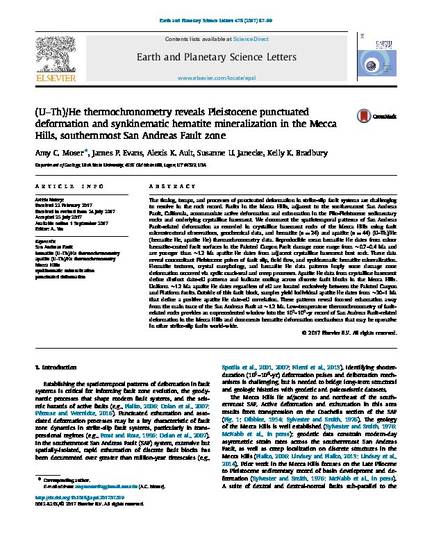
Article
(U–Th)/He thermochronometry reveals Pleistocene punctuated deformation and synkinematic hematite mineralization in the Mecca Hills, southernmost San Andreas Fault zone
Earth and Planetary Science Letters
(2017)
Abstract
The timing, tempo, and processes of punctuated deformation in strike-slip fault systems are challenging to resolve in the rock record. Faults in the Mecca Hills, adjacent to the southernmost San Andreas Fault, California, accommodate active deformation and exhumation in the Plio-Pleistocene sedimentary rocks and underlying crystalline basement. We document the spatiotemporal patterns of San Andreas Fault-related deformation as recorded in crystalline basement rocks of the Mecca Hills using fault microstructural observations, geochemical data, and hematite (n=24) and apatite (n=44) (U–Th)/He (hematite He, apatite He) thermochronometry data. Reproducible mean hematite He dates from minor hematite-coated fault surfaces in the Painted Canyon Fault damage zone range from ∼0.7–0.4 Ma and are younger than ∼1.2 Ma apatite He dates from adjacent crystalline basement host rock. These data reveal concomitant Pleistocene pulses of fault slip, fluid flow, and synkinematic hematite mineralization. Hematite textures, crystal morphology, and hematite He data patterns imply some damage zone deformation occurred via cyclic crack-seal and creep processes. Apatite He data from crystalline basement define distinct date-eU patterns and indicate cooling across discrete fault blocks in the Mecca Hills. Uniform ∼1.2 Ma apatite He dates regardless of eU are located exclusively between the Painted Canyon and Platform faults. Outside of this fault block, samples yield individual apatite He dates from ∼30–1 Ma that define a positive apatite He date-eU correlation. These patterns reveal focused exhumation away from the main trace of the San Andreas Fault at ∼1.2 Ma. Low-temperature thermochronometry of fault-related rocks provides an unprecedented window into the 105–106-yr record of San Andreas Fault-related deformation in the Mecca Hills and documents hematite deformation mechanisms that may be operative in other strike-slip faults world-wide.
Keywords
- San Andreas fault system fault processes
Disciplines
Publication Date
Fall 2017
Citation Information
Moser, A. C., Evans, J. P., Ault, A. K., Janecke, S. U., & Bradbury, K. K., 2017, (U–Th)/He thermochronometry reveals Pleistocene punctuated deformation and synkinematic hematite mineralization in the Mecca Hills, southernmost San Andreas Fault zone. Earth and Planetary Science Letters, 476, 87-99.
